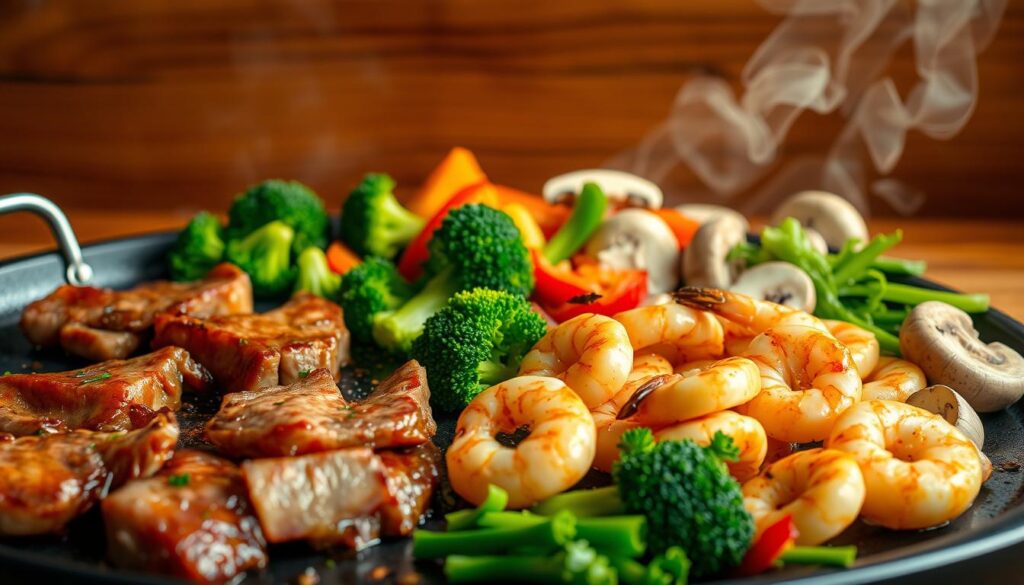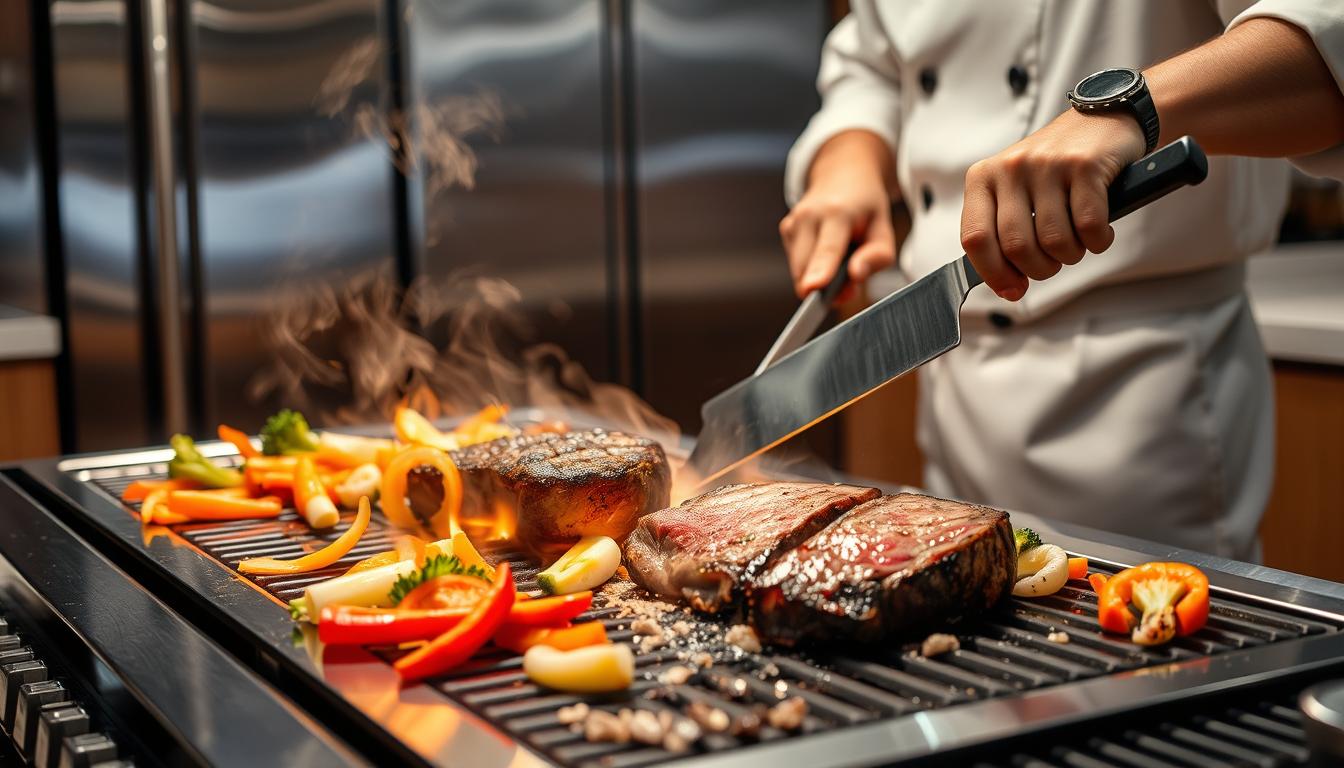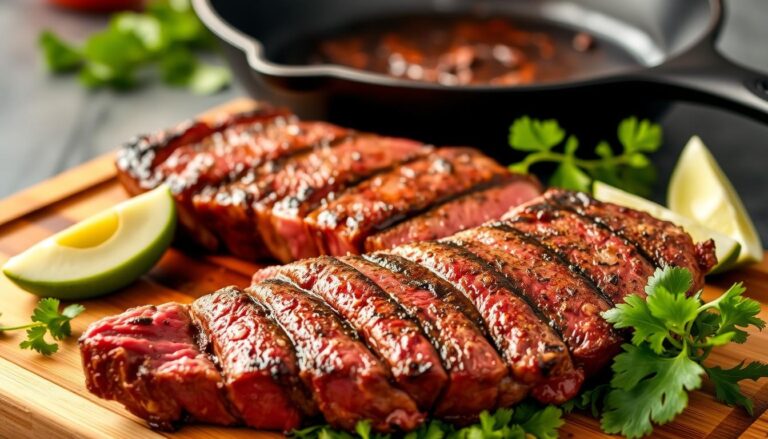How to make a delicious hibachi steak recipe at home
Want to enjoy the thrill of a hibachi steak recipe without the high cost? You can make it at home with ease. Just a few techniques and fresh ingredients can turn your kitchen into a hibachi grill.
Hibachi cooking is all about vibrant flavors and dramatic cooking. It lets you make restaurant-quality meals right in your kitchen. Whether you love cooking or just enjoy it on weekends, making a hibachi steak will wow your loved ones.
Table of Contents
Understanding Hibachi-Style Cooking
Hibachi cooking is a special way of cooking that makes meals exciting. It comes from Japan and has won the hearts of many food lovers. This includes those who love making hibachi steak recipes.
At its heart, hibachi cooking is about cooking food on a hot flat grill. It makes meals tasty and fun to watch. Chefs cook meats, veggies, and seafood with skill, entertaining everyone.
What is Hibachi Cooking?
Hibachi cooking uses a small, portable charcoal grill called a hibachi. These grills cook food fast at high heat. This keeps the meat tender and full of flavor.
Traditional vs Modern Hibachi Methods
| Traditional Hibachi | Modern Home Hibachi |
|---|---|
| Charcoal-based grill | Cast iron skillet or flat griddle |
| Professional chef performance | Home cooking with similar techniques |
| Limited to restaurant settings | Adaptable to home kitchen |
Essential Equipment for Home Hibachi
You don’t need fancy restaurant gear to make great hibachi steak recipes at home. A cast iron skillet or flat griddle works well. You’ll also need sharp knives, good cooking oils, and seasonings for real hibachi taste.
“Hibachi cooking is about more than food—it’s about creating an experience that delights all senses.” – Chef Masaharu Morimoto
Choosing the Perfect Cut of Steak
Choosing the right steak is key to a great hibachi recipe steak. It will impress your guests. The meat’s quality is what makes your hibachi cooking a success.

Boneless cuts are best for hibachi steak. Sirloin, tenderloin, and ribeye are great choices. They offer tenderness and flavor that’s perfect for hibachi.
Best Steak Cuts for Hibachi
Top chefs suggest certain cuts for hibachi steak. Top sirloin has great marbling and flavor. Tenderloin is super tender. Ribeye adds a rich, buttery taste.
Quality Indicators to Look For
| Quality Indicator | What to Check |
|---|---|
| Marbling | Fine white fat streaks throughout the meat |
| Color | Bright red with minimal brown spots |
| Texture | Firm with minimal moisture |
Proper Sizing and Preparation
Cut your steak into 1-inch pieces for hibachi style. This ensures even cooking and a perfect sear. Trim fat but keep enough for flavor and juiciness.
“The secret to great hibachi steak is in the cut and preparation.” – Professional Chef
Pro tip: Let your steak rest at room temperature for 30 minutes before cooking. This helps ensure even heat distribution and maximizes tenderness in your hibachi recipe steak.
Essential Ingredients for Hibachi Steak Recipe

Starting an authentic hibachi steak and shrimp recipe means picking the right ingredients. Your journey begins with the key parts that make hibachi taste so unique.
The main protein in your dish is the star. Go for top-quality beef like ribeye or sirloin, and add fresh, big shrimp. These proteins soak up the rich flavors that make hibachi special.
| Ingredient Category | Key Components |
|---|---|
| Liquid Seasonings | Soy sauce, mirin, rice vinegar |
| Aromatics | Fresh garlic, ginger, green onions |
| Oils | Sesame oil, vegetable oil |
Your kitchen needs key seasonings like sesame seeds, white pepper, and kosher salt. These turn a simple steak into a top-notch hibachi dish. Using fresh ingredients is key to getting that real hibachi taste.
“The secret to great hibachi cooking lies in the quality of your ingredients and the precision of your technique.”
Every ingredient is important for adding flavor. Mix them carefully to make a hibachi steak and shrimp recipe that will wow your guests.
Creating the Perfect Hibachi Steak Marinade
Making a great hibachi steak recipe begins with a tasty marinade. This marinade turns regular meat into a dish fit for a restaurant. The right mix of ingredients makes your steak unforgettable, adding deep flavors and tenderizing it for a fantastic meal.

Core Marinade Components
Your hibachi steak needs a marinade with savory, sweet, and umami flavors. Soy sauce is key, adding saltiness and depth. Sesame oil brings a nutty taste, while garlic and ginger add a fresh, aromatic touch.
| Ingredient | Flavor Profile | Quantity for 1 lb Steak |
|---|---|---|
| Soy Sauce | Salty, Umami | 1/4 cup |
| Sesame Oil | Nutty, Rich | 2 tablespoons |
| Minced Garlic | Pungent, Aromatic | 3 cloves |
| Grated Ginger | Spicy, Bright | 1 tablespoon |
Marination Timing and Techniques
For the best hibachi steak, marinate it for 30 minutes to 2 hours. Don’t marinate too long, as it can make the meat tough. Always marinate in the fridge, turning the steak to ensure even flavor.
Flavor Enhancement Tips
Try adding rice vinegar for a tangy taste or honey for sweetness. Brown sugar helps with caramelization when grilling. Pat your steak dry before cooking to get that perfect sear and keep the marinade flavors inside.
Preparing Your Cooking Station
Setting up the right cooking station is key for a great steak hibachi recipe at home. Your workspace is what makes your dish a success. Start by clearing a big area near your stovetop or grill. Make sure you have enough space to move around while cooking your steak.
Before you start cooking, gather all the tools you need. Professional chefs say to have these items close by:
- Sharp chef’s knife
- Cutting board
- Tongs
- Spatula
- Meat thermometer
- Large skillet or griddle
Getting the temperature right is important in hibachi cooking. Make sure your cooking surface is hot before adding your steak. A cast-iron skillet or flat-top griddle is best for that perfect hibachi sear. Keep the heat medium-high to high to get those tasty caramelized edges on your steak.
Remember, safety is always first when cooking your hibachi steak. Have a fire extinguisher ready, wear heat-resistant gloves, and use long-handled utensils to avoid burns. Keep the area clear of anything that could catch fire and keep your cooking space clean and organized.
Pro tip: Mise en place is key – have all ingredients chopped, measured, and ready before you start cooking!
Step-by-Step Hibachi Steak Recipe
Making hibachi steak at home is simpler than you think. With the right steps and skills, your kitchen can become a sizzling hibachi grill. The key is in preparation, precise cooking, and managing heat and timing.
Preparation Phase
Before cooking, make sure your ingredients are ready. Dry your steak with paper towels to remove moisture. This helps get a perfect sear and a golden-brown crust. Season with salt and pepper, then let the meat rest at room temperature for 30 minutes.
Cooking Instructions
Heat your griddle or skillet to high. Use oil with a high smoke point, like vegetable or canola oil. Place your steak on the hot surface and cook without moving for 2-3 minutes. This creates a beautiful caramelized exterior.
Timing and Temperature Guide
| Doneness | Cooking Time | Internal Temperature |
|---|---|---|
| Rare | 2 minutes per side | 125°F |
| Medium Rare | 3 minutes per side | 135°F |
| Medium | 4 minutes per side | 145°F |
| Well Done | 5 minutes per side | 160°F |
Use a meat thermometer to check doneness and avoid overcooking. After cooking, let your steak rest for 5-7 minutes. This allows juices to redistribute, making your steak tender and flavorful.
Making the Signature Yum Yum Sauce
Your hibachi recipe steak isn’t complete without the legendary Yum Yum sauce. This creamy, tangy condiment turns an ordinary meal into a restaurant-quality experience. Making this sauce at home is surprisingly simple and lets you customize flavors to your liking.
The classic Yum Yum sauce needs just a few key ingredients. Mayonnaise is the base, giving it a rich and smooth texture. Ketchup adds a subtle sweetness, while vinegar introduces a zesty tang. Garlic powder brings depth, and optional spices like paprika can make the sauce more complex.
| Ingredient | Quantity | Purpose |
|---|---|---|
| Mayonnaise | 1 cup | Creamy base |
| Ketchup | 2 tbsp | Sweetness |
| Rice Vinegar | 1 tbsp | Tanginess |
| Garlic Powder | 1/2 tsp | Flavor depth |
Making the sauce is easy. Just mix all ingredients in a bowl and whisk until smooth. For the best taste, refrigerate for at least an hour before serving. This lets the flavors meld, making the sauce a perfect match for your hibachi recipe steak.
Pro tip: Try adding spices like smoked paprika or cayenne pepper to make your own unique sauce. Your homemade Yum Yum sauce will wow your dinner guests and take your hibachi-style cooking to the next level.
Cooking Perfect Hibachi Fried Rice
Making the perfect fried rice is key to a great hibachi steak and shrimp dish. The right steps turn simple ingredients into a side dish that’s just like what you’d find in a restaurant. It’s a perfect match for your main course.
Rice Selection Secrets
Choosing the right rice is essential for your hibachi dish. Short-grain Japanese rice is best for that classic texture. It’s better to use day-old rice because it’s drier. This helps prevent clumps when you cook it.
Cooking Techniques That Make a Difference
High heat is important for cooking hibachi fried rice. Use a large wok or flat griddle for even heat. Stir-frying quickly keeps the rice grains separate and adds tasty caramelized edges.
Vegetable and Seasoning Magic
Add fresh veggies like carrots, peas, and green onions to your dish. Soy sauce, sesame oil, and garlic give it authentic Japanese flavors.
| Ingredient | Quantity | Purpose |
|---|---|---|
| Cooked Rice | 3 cups | Base of the dish |
| Eggs | 2 | Protein and texture |
| Mixed Vegetables | 1 cup | Flavor and nutrition |
| Soy Sauce | 2 tablespoons | Seasoning |
Pro tip: Always use a hot pan and keep ingredients moving to prevent sticking and ensure even cooking.
Hibachi-Style Vegetable Preparation
Creating the perfect hibachi steak recipe isn’t just about the meat. Vegetables are key for authentic flavor and nutrition. Choosing the right vegetables and preparing them right can make your meal better.
For your hibachi vegetables, pick crisp, colorful ones that cook fast and match the steak. Zucchini, onions, mushrooms, and carrots are great choices. They add vibrant colors and textures to your dish. Cut them into uniform pieces for even cooking and a nice look.
How you prepare your vegetables is important for that hibachi taste. Slice them thinly and evenly. This helps them cook quickly and stay crisp. Add a light soy sauce and butter mix for a savory glaze, just like in traditional hibachi cooking.
| Vegetable | Cutting Technique | Cooking Time |
|---|---|---|
| Zucchini | Diagonal slices | 2-3 minutes |
| Onions | Thin strips | 3-4 minutes |
| Mushrooms | Quartered | 2-3 minutes |
| Carrots | Julienne | 3-4 minutes |
When cooking your hibachi steak, add vegetables to the hot griddle or pan after searing the meat. This way, they stay crisp and vibrant. They provide a great contrast to the tender steak. Try different vegetable mixes to find your favorite hibachi-style combination.
Plating and Presentation Tips
Creating a real hibachi dining experience is more than just cooking. The way you present your steak hibachi recipe can turn a simple meal into a top-notch experience. Plating is an art that boosts your cooking skills and makes every bite a delight.
Your steak hibachi recipe needs a stunning presentation that shows off traditional Japanese cooking. Choose a large, neutral-colored plate that lets your dish’s colors shine. The plate should be a bit bigger than your food to make each part stand out.
Restaurant-Style Arrangement Techniques
Professional chefs know how to arrange food for visual appeal. Cut your hibachi steak at a 45-degree angle, fanning the slices to show off the perfect doneness. Place the steak on one side of the plate, leaving space for fried rice and grilled veggies.
Garnishing Like a Pro
Garnishes can make your steak hibachi recipe truly special. Sprinkle chopped green onions over the dish for a burst of color. Add a small dollop of yum yum sauce on the side, making a beautiful swirl that encourages diners to mix flavors.
“Presentation is the final touch that transforms a home-cooked meal into a culinary masterpiece.” – Professional Chef Recommendation
The aim is to create a plate that looks as good as it tastes. Your steak hibachi recipe should tell a story through its arrangement. It should invite everyone to enjoy both the flavor and the artistry of your cooking.
Storage and Reheating Guidelines
Keeping your hibachi steak fresh requires the right storage and reheating. After you’ve enjoyed your meal, you’ll want to keep the leftovers tasty for later.
Always use airtight containers to store hibachi steak. Refrigerate it quickly, keeping it below 40°F. This way, your steak will stay good for 3-5 days.
| Storage Method | Duration | Best Practices |
|---|---|---|
| Refrigeration | 3-5 days | Use airtight containers, store below 40°F |
| Freezing | 2-3 months | Wrap tightly in freezer-safe packaging |
Reheating hibachi steak needs care to keep it moist. Use a skillet on low heat or an oven at 250°F. Add beef broth or water to keep it moist. Don’t use the microwave, as it can make the steak tough.
To reheat hibachi fried rice and vegetables, do it separately. Stir-fry rice in a hot pan with oil. Warm vegetables quickly to avoid overcooking. These steps will make your steak as tasty as when it was first made.
Common Mistakes to Avoid
Making the perfect hibachi recipe steak needs skill and focus. Many home cooks face challenges that can ruin their dish. Knowing these common mistakes will help you make a great hibachi steak at home.
Temperature Control Challenges
Getting the right heat is key for your hibachi steak. If the pan isn’t hot enough, you’ll get steamed meat instead of a nice sear. Make sure your cooking surface is very hot before adding the steak. Heat your griddle or cast-iron skillet for at least 5 minutes to get that perfect hibachi-style caramelization.
Seasoning Pitfalls
Seasoning is vital for your hibachi steak. Many cooks either don’t season enough or too much. Use a mix of salt, pepper, and light seasonings. Kosher salt is best for a flavorful crust. Season generously but carefully to boost the steak’s flavor without overpowering it.
Timing Mistakes to Prevent
Timing is critical in hibachi cooking. Overcooking can make your steak tough. Use a meat thermometer to check if it’s done. For medium-rare, aim for an internal temperature of 135°F. Let the meat rest for 5-7 minutes after cooking to keep it tender.
Pro Tip: Practice makes perfect when mastering hibachi steak techniques!
Conclusion
Making a tasty hibachi steak recipe is easier than you think. With the right tools and ingredients, your kitchen can become a mini hibachi grill. Learning this skill takes time, patience, and a love for trying new flavors and methods.
As you get better at making hibachi steak, your skills will grow with each try. Begin by mastering the basics like choosing the right meat, marinating it well, and controlling the temperature. Remember, even pros started from scratch. Your homemade hibachi steak can be just as good as what you get at restaurants, and it’s more personal.
There’s nothing quite like cooking a top-notch hibachi steak in your own kitchen. By learning the details of hibachi cooking, picking the best ingredients, and honing your cooking skills, you’ll make meals that wow everyone. Enjoy the journey of learning hibachi cooking at home.
Now that you know how to make hibachi steak, you can unleash your creativity in the kitchen. Keep trying new things, improving your skills, and most importantly, have fun. Every meal is a chance to grow as a chef and make unforgettable memories.




